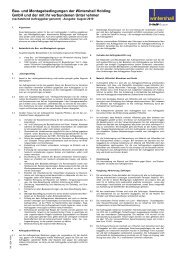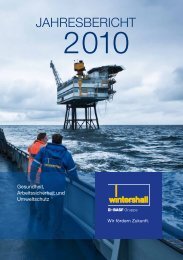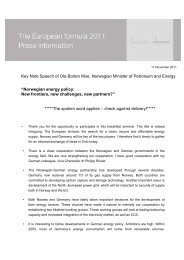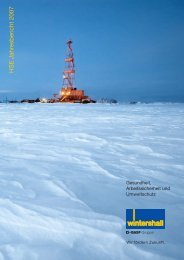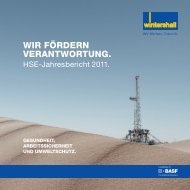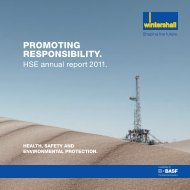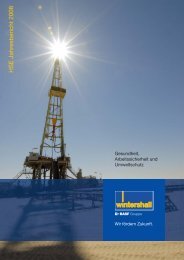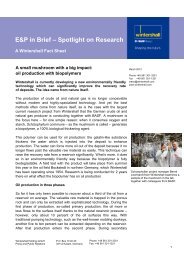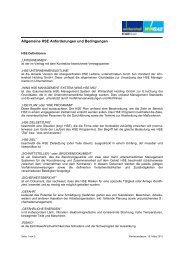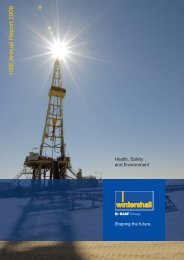HSE Annual Report 2010 (English) - WINTERSHALL
HSE Annual Report 2010 (English) - WINTERSHALL
HSE Annual Report 2010 (English) - WINTERSHALL
You also want an ePaper? Increase the reach of your titles
YUMPU automatically turns print PDFs into web optimized ePapers that Google loves.
OFFSHORE ENvIRONMENTAL PROTECTION.<br />
The North Sea has been one of the world’s most<br />
important hydrocarbon production regions for<br />
decades. Wintershall itself has been involved in<br />
producing natural gas there since 1965 and operates<br />
26 platforms in its southern part. It also has<br />
offshore activities in Argentina and Libya. The expansion<br />
of offshore expertise is generally gaining<br />
importance in the exploration and production of<br />
oil and gas, and the company applies this expertise<br />
to its activities in other regions of the world.<br />
Wintershall Noordzee is based in Rijswijk near<br />
The Hague, and is home to the corporate-wide<br />
competence center for offshore technology.<br />
RECYCLING OFFSHORE pLATFORMS<br />
The conditions for producing oil and gas at sea<br />
are challenging. A production platform must be<br />
equipped to cope with the wind, weather, heavy<br />
seas, water quality and much, much more. The<br />
average service life of a platform is approximately<br />
25 years. After this they are usually disassembled<br />
and scrapped. Wintershall has now logically and<br />
beneficially combined ecology and economy in this<br />
area with the conversion and modernization of two<br />
platforms in the Dutch sector of the North Sea.<br />
In addition to natural gas production platform<br />
L5-C, E18-A has also been completely converted<br />
and modernized so that it can be moved on and<br />
produces elsewhere. The conversion of the old<br />
platforms saves costs, time and material compared<br />
to a completely new construction, as a large part<br />
of the installations can be reused.<br />
The predecessor to the E18-A platform, p14-A,<br />
was built in 1993, later dismantled at its location<br />
in the Dutch sector of the North Sea and towed<br />
to a shipyard in Rotterdam. The platform’s body,<br />
with its several decks and a helipad, were completely<br />
reconditioned and modernized at a yard<br />
in Ridderkerk. Reuse of a large part of the p14-A<br />
platform meant that 500 tons of steel and a considerable<br />
amount of energy – around 2.5 million<br />
kWh – were saved. The E18-A was equipped<br />
solely with electric generators to minimize emissions.<br />
A supply line to the adjacent F16-A provides<br />
the E18-A with electricity and operating resources<br />
and enables data to be transferred. As a result, it<br />
was possible to reduce the number of visits to the<br />
platform, which meant fewer helicopter flights and<br />
ship transports, hence reducing emissions.<br />
MITTELpLATE<br />
The Mittelplate platform in the UNESCO world<br />
cultural heritage site of the Wattenmeer in<br />
Schleswig-Holstein is the only oil producing<br />
facility operated from German waters. New and<br />
innovative technical solutions were necessary<br />
to develop the crude oil reserves at Mittelplate<br />
safely and ecologically. The 70 by 95 meter platform<br />
was built on the tidelands of the Mittelplate<br />
and protected on the sea side by a liquid-tight<br />
concrete-and-steel basin with sheet pile walls<br />
of eleven meters in height, so that there can be<br />
no uncontrolled discharges or seepage from it.<br />
Drilling and production operations are protected<br />
by sophisticated monitoring and control systems<br />
that provide multiple safeguards. Subsurface and<br />
surface safety valves can be activated automatically,<br />
manually and by remote control. Finally,<br />
laying a pipeline to the Dieksand land-based<br />
station eliminated the need for around 2,000 ship<br />
movements to remove the crude oil in doublehulled<br />
vessels.<br />
HEALTH SAFETY ENVIRONMENT



